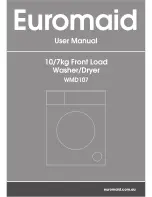
26
Problems
Possible causes
Action
• Too high dosage of rinse
aid.
• Certain food remnants
such as mustard, mayon-
naise, lemon, vinegar, salt
and dressings can cause
stains on stainless steel if
allowed to remain for any
length of time. All stainless
steel can mark silver if
allowed to come into contact
during the dishwashing
process. Aluminium can
also cause stains on dishes.
• Lipstick and tea can be
difficult to remove.
• The dishes are not prop-
erly loaded or the spray
arms are not rotating.
• You have forgotten to
switch on the main switch.
• The door is not properly
closed.
• A fuse has blown.
• The plug is not plugged in.
• The water tap is off.
• Overfilling/leakage
• A droning sound (drainage
pump) can be heard from
the machine, this does not
stop when the power is
switched off using the main
power switch.
• Reduce dosage. See the
chapter on rinse aid. If the
water is very soft, you could
try diluting the rinse aid (1
part rinse aid, 1 part water).
• Rinse off food residue of
this type if you do not intend
to start the dishwasher
immediately.
• Seperate your cutlery into
the various compartments in
the basket. Make sure silver
and stainless steel are not
together.
• Change to a detergent with
bleach.
• Check that the china is
loaded securely. Spin the
spray arms to make sure
that they rotate.
• Check
• Check
• Check
• Check
• Check
1. Close the water tap.
2. Pull out the plug.
3. Call a service engineer
The china has a whitish-
blue sticky film.
Stains on stainless steel
or silver.
Stains which remain after
dishwashing.
Rattling sound during
dishwashing.
The machine will not start.
To restart the machine,
press Start/stop for 3
seconds. Now select a
new programme and
press Start/stop.
Summary of Contents for D3132
Page 1: ...Use Care Guide Dishwasher ASKO D3132 ...
Page 34: ...34 Own comments ...
Page 35: ...35 Own comments ...











































